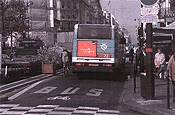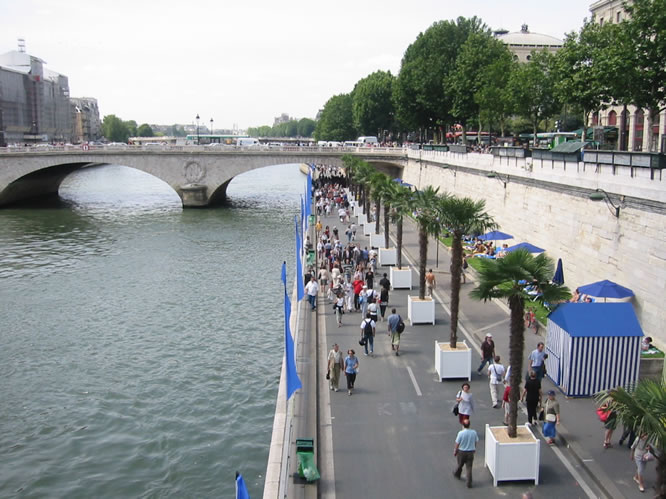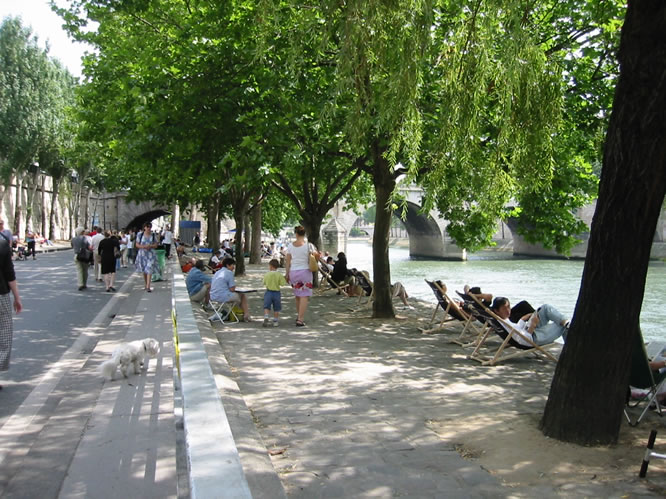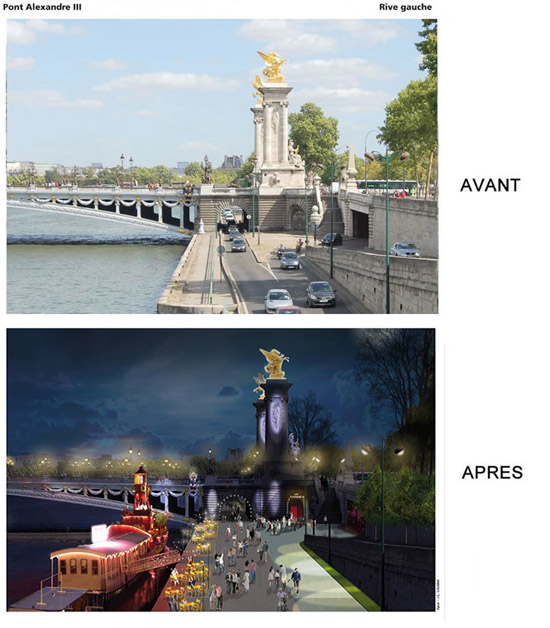Removing Freeways - Restoring Cities
Produced by the
Preservation Institute
Introduction:
Tear It Down!
by John Norquist
San Francisco, CA:
Embarcadero Freeway
San Francisco, CA:
Central Freeway
Milwaukee, WI:
Park East Freeway
Toronto, Ontario: Gardiner Expressway
New York, NY:
West Side Highway
Niagara Falls, NY:
Robert Moses Parkway
Paris, France:
Pompidou Expressway
Seoul, South Korea
Cheonggye Freeway
Freeway Removal
Plans and Proposals
Conclusion:
From Induced Demand
to Reduced Demand
by Charles Siegel
Paris, France
Georges Pompidou Expressway
In 2001, some Parisian drivers were furious because their new mayor, Bertrand Delanoë, not only converted street lanes to transit lanes but also closed the Georges Pompidou Expressway to drivers for a month during the summer, as a centerpiece of his efforts to fulfill his campaign pledge to reduce automobile use. Drivers complained that, within a few months of being elected, Delanoë had caused so much congestion that traffic on the city’s Boulevard St.-Germain backed up all the way to the Boulevard Périphérique.
In 2002, rather than retreating, Delanoë converted this freeway on the Seine River to Paris-Plage (Paris Beach) for a month during the summer. He brought in sand, palm trees, a climbing wall, and ball courts. Parisians sunbathed by the Seine during the day, and strolled and listened to concerts there in the evening.
Paris-Plage attracted 2,000,000 people during the summer of 2002. It was so popular that it has become a regular yearly event. It has also helped promote Paris' plans to reduce traffic dramatically and to close the Pompidou Expressway permanently.
Pompidou and his Expressway
Georges Pompidou was Premier of France from 1962 to 1968, under the Presidency of Charles De Gaulle. In 1969, less than a year after losing the Premiership, he was elected to succeed De Gaulle as President, and he remained President until his death in 1974 at age 62.
Pompidou was also a great lover of the automobile, and as Premier, he argued that a freeway should replace the grass-covered bank of the Seine by saying: "les Français aiment leurs bagnoles" (the French love their cars).
On March 27, 1966, Paris made the decision that existing roadways along the Seine should be connected to create a continuous expressway along the Seine through the center of Paris. The Voie Georges Pompidou (George Pompidou Expressway) was completed in 1967, and ran along the right bank of the Seine for 13 kilometers, connecting with the Boulevard Périphérique (Peripheral Boulevard) that circles central Paris at both ends.
Fortunately, there was only room on the riverbank for a two-lane expressway. Pompidou wanted to cover the Seine with concrete to create room for a wider expressway, but the environmental movement and freeway revolt stopped any further freeway expansion in Paris.
The New Regime of Bertrand Delanoë
Bertrand Delanoë was elected mayor of Paris in March, 2001, after running on a platform that promised to support public transportation, walking, and bicycling at the expense of the automobile. A conservative city government that supported more automobile use was suddenly replaced by a Socialist-Green government that promised to reduce automobile use. Delanoë is a Socialist and is also gay.
Delanoë had served in the city council and city senate of Paris since 1976, and he was president of the Socialist group in the city council from 1993 to 2001. Delanoë focused his mayoral campaign on the pollution caused by increasing automobile use in the city, promising to "fight, with all the means at my disposal, against the harmful, ever-increasing and unacceptable hegemony of the automobile.”
In his inaugural address, Delanoë quoted the composer Erik Satie, who (Delanoë said) summed up the opinion of many Parisians when he said, “L’air de Paris est si mauvais que je le fais toujours bouillir avant de respirer.” – the air of Paris is so bad that I always boil it before breathing. Then he stated his two major initiatives to improve transit: reserved bus corridors on major streets, to speed up bus service, and a new tramway around the periphery of Paris.
During its first year, his government also developed a plan for sustainable development of Paris, saying that “limitation of the many nuisances associated with automobile traffic are at the heart of” the plan. Among other things, the plan called for:
- a new division of public space, more favorable to bus, pedestrians, bicyclist, and roller skaters.
- better public transit service.
- parking policies that reduce automobile use, by favoring residential parking over commuter parking.
- a complete set of bicycle routes through the city
- “quartiers verts” (green neighborhoods) in the center of Paris, with one-way streets that would make it impossible for through traffic to use local streets.
The two initial projects that came out of this plan had some success. A new tramway line was created, and 15 kilometers of car-free bus-bike-taxi lanes were built.

The Delanoë government created exclusive bus-bike-taxi lanes in Paris,
separated from traffic lanes by planters and other types of barriers.
The city government fell behind its goal of creating 41 kilometers of car-free bus-bike-taxi lanes a year, because these lanes needed approval of the national police, who are not answerable to the mayor and who do listen to complaints of drivers. The lanes that were built were not not completely successful, because there were complaints that speeding taxis were a threat to bicyclists, but they did speed up bus service, reducing trip times by an estimated 10 to 20 percent – and they caused temporary traffic jams while traffic patterns were changing to adjust to the new street capacity.
From Pompidou Expressway to Paris-Plage
In the summer of 2002, as a symbolic centerpiece to this new transportation policy, the Delanoë government closed the Pompidou Expressway to cars from July 15 to August 15 between between 6am and 11pm – just a few months after after he was elected. This is a time when many Parisians are out of the city on vacation, but it is also a time when the city does most construction work on the streets, which causes traffic jams in itself.
For several years previously, the expressway was closed to traffic for a few hours during Sundays in late July and August. The longer-term closure came as a surprise to many motorists, because it was done without adequate notification to the public. About 70,000 cars a day normally use this expressway, and when they were suddenly displaced, there were traffic jams on parallel routes, such as boulevard Saint-Germain. Drivers complained that they were suffering for no reason, because the closed expressway was not heavily used by pedestrians.
In response to these criticisms, the Forum of Young Greens of d'Ile-de-France Green Party, joined by several Green city councilmembers, held a ceremony to “debaptize” the expressway, so it would no longer be named after Pompidou. A couple of days later gave it the new name “Voie de La Velorution.” (The word “velorution” is a play on the words “revolution” and “velo,” French for bicycle.) But Delanoë condemned this effort, and one of his aides commented, “One should not joke about the name and memory of a former president of the republic.”
The first moves to reserve lanes for buses came shortly after the expressway closing. The Rue de Rivoli, which was congested when it was three lanes, became more congested temporarily when a lane was reserved for buses and only two were left for cars. This plan also provoked intense criticism. Yves Galland of the centrist UDF party said the plan was " actually increasing pollution in Paris by blocking the traffic." And Jean-Pierre Jerabek of the Ile-de-France Automobile Club said, "Car use is not a whim, it's essential for people's work, especially those who live in the suburbs. People want traffic to flow better in Paris, not worse. Mr Delanoë must rid himself of this idea that motorists will just abandon their cars."
Delanoë responded that he expected "a bit of initial fuss" when streets were closed. He added "I'm not obsessed by cars. I'm obsessed with the health of Parisians. Is it my fault that the automobile is the city's major source of pollution and that it takes up two-thirds of the road surface? Things have to be brought back into balance - that's what our policy is all about."
Despite the criticism, a poll found that 66% of Parisians approved the 2001 closure of the Pompidou expressway, both because it made the banks of the Seine more pleasant and because it limited air pollution. Approval was strongest among young people, women, and those who did not use or rarely used cars. Because 56% of Parisians do not own cars, Delanoë had a good reason to expect support for his policies.
The city government decided to do a better job of closing the expressway the following summer. It gave more advance notice to motorists, it closed the road a week later, when more Parisians were out of the city, and it planned to attract more people by converting the expressway’s right of way into “Paris Plage” – Paris beach.

A view of Paris Plage
To create Paris Plage, the city closed the road 24 hours a day. At a cost of 1.5 million euros, it brought palm trees in wooden planters, beach umbrellas, beach chairs, a climbing wall, outdoor cafes, refreshment stands, bicycle rentals, and enough sand to create small areas of sandy beaches in addition to the grassy beaches made up of the grassy shoulders of the road. It also planned entertainment, such as clowns, jugglers, and street artists during the day, and concerts with dancing during the evenings. But this would be a beach where no one would go in the water: swimming in the Seine is forbidden because of pollution.

Paris Plage: Enjoying the shade.
Between July 21 and August 18, 3.8 kilometers (over two miles) of the expressway was closed to create this beach, from the Tuileries west of the Louvre to Quai Henri IV, beyond Ile St Louis. Paris-Plage was more popular than anyone had expected: it attracted 600,000 visitors on the first day alone, and it attracted 2 million visitors during the entire time that the freeway was closed and the beach was open. Le Monde commented that the operation “silenced critics from the municipal right, strengthened the good image of the mayor of Paris, and ... was a true popular success.”
Permanent Closure of the Pompidou
Because of this success, the summer closure of the Pompidou Expressway to create Paris-Plage has become a regular yearly event, and the city government began talking about a complete closure of the expressway.
In 2007, Delanoë unveiled a dramatic plan to cut automobile use in Paris by 40% and to reduce the city’s greenhouse gas emissions by 60%. This new plan would create a network of “civilized thoroughfares” that give priority to buses and bicycles, would extend tramways, would create a new suburban commuter train line, and would pedestrianize the banks of the Seine entirely, removing the Ponpidou Expressway.
In 2010, Delanoë unveiled a plan to close the Pompidou Expressway to cars permanently and convert it into a pedestrian zone and also to convert the expressway across the Seine on the right bank from a road for cars only into a boulevard designed for both pedestrians and cars. The project would redevelop 35 acres of riverside at an estimated cost of $50 million. When he introduced the project on April 14, 2010, Delanoë said "It's about reducing pollution and automobile traffic, and giving Parisians more opportunities for happiness. If we succeed in doing this, I believe it will profoundly change Paris."
In 2016, Paris' new mayor, Anne Hidalgo, and City Council committed to a permanent closure of two miles of the Pompidou Expressway, opening the space to pedestrians and cyclists. The project will cost about $50 million and is expected to have economic benefits for a tourism. The project received broad support partly because policies to reduce automobile use have succeeded: only 40% of Parisians own cars now, compared with 60% 15 years ago.
The picture below shows the Pompidou Expressway as it looked before and as it might look after this change.

Left Bank Before and Visualized After the Change
Text copyright 2007, 2016 by The Preservation Institute